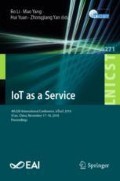Abstract
The full-duplex technology with the same frequency and the same time has developed rapidly in the wireless communication field. Compared with the traditional half-duplex technology, full-duplex technology can obtain the double spectral efficiency and throughput. However, in low-frequency asymmetric full-duplex communication, AP has full-duplex, and STA only has half duplex. And the interference between STAs results that we still cannot reach the theoretical multiple throughput. In this paper, we use the feature of directional propagation of mm wave to eliminate the interference between STAs in asymmetric full-duplex communication, and the full-duplex is applied to the WIFI high-frequency field for the first time. This paper introduces the BI frame of MAC architecture of IEEE 802.11 ay protocol in mmWave WIFI network, and designs the SP period of BI frame. So in SP period, the AP has full-duplex function and STAs still are half-duplex. We use Matlab to simulate, and get the theoretical multiple throughput.
Access this chapter
Tax calculation will be finalised at checkout
Purchases are for personal use only
References
Chiao, B., Ma, M.: Analysis on full-duplex technology with the same frequency. Telecommun. Netw. Technol. (11), 29–32 (2013)
Liu, X.: Research on key technologies of full-duplex radio frequency wireless communication system. Beijing University of Posts and Telecommunications (2017)
Li, J.: Research and analysis on the effects of full-duplex system Zhonggan ratio on its performance. Harbin Institute of Technology (2014)
Wang, L., Xu, H.: Capacity analysis and comparison of traditional semi-duplex and pure full-duplex wireless communication systems. Mob. Commun. (18), 63–68 (2014)
Choi, J.I., Jain, M., Srinivasan, K., et al.: Achieving single channel full duplex wireless communication. In: International Conference on Mobile of Systems, pp. 301–312 (2011)
Duarte, M., Dick, C., Sabharwal, A.: Experiment-driven characterization of full-duplex wireless systems. IEEE Trans. Wirel. Commun. 12, 4296–4307 (2012)
Zou, N.: IEEE802.11 AD standard and application. Inf. Technol. Stand. (3), 41–44 (2013)
Huang, X.L.: Construction of wireless network in laboratory based on IEEE802.11ad technology standard. J. Tonghua Normal Univ. (2017)
ISO/IEC/IEEE ISO/IEC/IEEE International Standard for Information technology-Telecommunications and information exchange between systems-Local and metropolitan area networks-Specific requirements-Part 11: Wireless LAN Medium Access Control (MAC) and Physical Layer (PHY) Specifications Amendment 3: Enhancements for Very High Throughput in the 60 GHz Band (adoption of IEEE Std 802.11ad-2012)
ISO/IEC/IEEE 8802–11:2012/Amd.3:2014(E) (2014)
Shi, L., Fapojuwo, A., Viberg, N., Hoople, W., Chan, N.: Methods for calculating bandwidth, delay, and packet loss metrics in multi-hop IEEE802.11 ad hoc networks. In: VTC Spring 2008 - IEEE Vehicular Technology Conference (2008)
Mohammadi, M., Chalise, B.K., Hakimi, A., Mobini, Z., Suraweera, H.A., Ding, Z.: Beamforming design and power allocation for full-duplex non-orthogonal multiple access cognitive relaying. IEEE Trans. Commun. 66, 5952–5965 (2018)
Acknowledgement
This work was supported in part by the National Natural Science Foundations of CHINA (Grant No. 61771392, No. 61771390, No. 61501373, and No. 61271279), the National Science and Technology Major Project (Grant No. 2016ZX03001018-004, and No. 2015ZX03002006-004), the Fundamental Research Funds for the Central Universities (Grant No. 3102017ZY018), and the Science and Technology on Communication Networks Laboratory Open Projects (Grant No. KX172600027).
Author information
Authors and Affiliations
Corresponding author
Editor information
Editors and Affiliations
Rights and permissions
Copyright information
© 2019 ICST Institute for Computer Sciences, Social Informatics and Telecommunications Engineering
About this paper
Cite this paper
Li, Y., Zhao, P., Li, B., Yang, M., Yan, Z. (2019). Full Duplex Enabled Next Generation mmWave WiFi Network. In: Li, B., Yang, M., Yuan, H., Yan, Z. (eds) IoT as a Service. IoTaaS 2018. Lecture Notes of the Institute for Computer Sciences, Social Informatics and Telecommunications Engineering, vol 271. Springer, Cham. https://doi.org/10.1007/978-3-030-14657-3_25
Download citation
DOI: https://doi.org/10.1007/978-3-030-14657-3_25
Published:
Publisher Name: Springer, Cham
Print ISBN: 978-3-030-14656-6
Online ISBN: 978-3-030-14657-3
eBook Packages: Computer ScienceComputer Science (R0)

